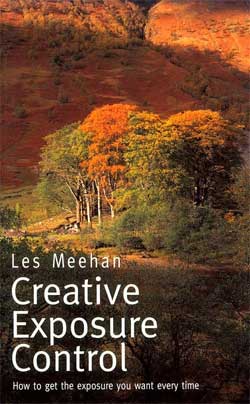 Creative Exposure Control Creative Exposure Control
Les Meehan
Amphoto, $24.95 US/$38.95 CN
ISBN 0-8174-3727-4

Review by Stephen C. Peterson
From Vol. 2 No. 5
Photography involves two main skills: Vision and Technique. This book (CEC) emphasizes technique but with the goal of enabling vision. CEC is divided into three sections: Factors influencing exposure, exposure assessment and creative exposure techniques.
The first section covers the basic relations between aperture, shutter, film, lighting ratios, subject brightness range, reciprocity correction, filters and magnification. Each bite-sized topic is covered on the two open pages, a technique often associated with British publications. Most topics include a “Practical Task,” an experiment that the reader is encouraged to do. These experiments demonstrate and reinforce to the reader the material covered in the topic.
The second section covers metering in good detail as well as zone system basics again with the inclusion of Practical Tasks. Of interest to many photographers Meehan applies the zone system to both color and black and white films. Many of us forget that color film contrast can be altered (controlled) during the first development stage, though to a more limited extent than black and white because of color shifts. Meehan describes this and suggests appropriate filters for experimentation.
The third section builds on these basics and moves into how technique can enhance visualization. Although the Practical Tasks continue this section also includes “Case Studies,” where Meehan himself illustrates the fine points of visualization and technique. Of particular interest was Meehan’s illustration of pre-exposure to provide shadow detail with color films. He also clearly discusses zone system application and development.
An Appendices section is also very useful in that it describes a zone scale for lenses and the construction of a zone dial, for cameras with TTL metering. A visualization aid, a card with an appropriately sized rectangular cutout is described; this is one of my own favorite tools. Film speed and development tests are also described in some detail here.
All in all, this modest book admirably succeeds in its goal of addressing the major aspects of Creative Exposure Control. I would recommend it to both the beginner as well as the more advanced photographer who might be struggling with aspects of exposure. It would make a good text for a beginning course in photography. SCP
|